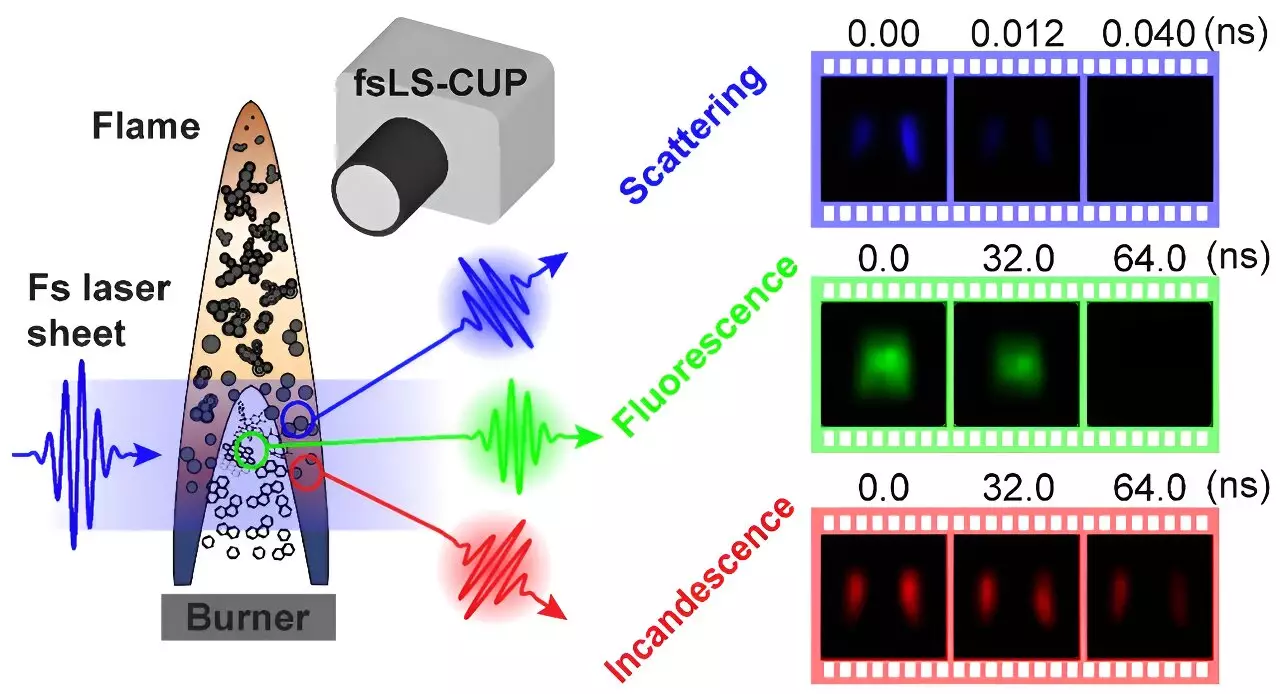In recent advancements in ultrafast imaging, researchers have made a substantial leap that could transform our understanding of both fundamental sciences and various applied fields. Conventional methods of imaging tiny particles generated from combustion and other dynamics have long posed challenges due to the rapid changes these particles undergo. A team led by scientists from the California Institute of Technology has introduced a groundbreaking technique named femtosecond laser sheet-compressed ultrafast photography (fsLS-CUP), which remarkably captures fleeting phenomena at an astonishing rate of 250 billion frames per second. This innovation is set to redefine the boundaries of science and technology, particularly in the realms of combustion chemistry and astrochemistry.
For years, capturing the brief existence of carbon-based particles, such as soot and polycyclic aromatic hydrocarbons (PAHs), has been a significant challenge in combustion studies. These harmful particles not only pollute the environment but also play critical roles in many scientific phenomena, extending to cosmic settings where they constitute a substantial component of interstellar matter. Traditional imaging systems, though useful for many applications, have limitations that render them inadequate for documenting the ultra-short lifetimes of these particles, which range from nanoseconds to mere femtoseconds. Existing cameras can achieve a maximum of a few million frames per second and frequently necessitate multiple laser pulses. Such methods often lead to the unwanted heating of materials and capture only repeatable events through an elaborate stitching process, which fails to capture non-repetitive dynamic interactions.
The fsLS-CUP system addresses these challenges head-on, utilizing a single femtosecond laser pulse to achieve unparalleled imaging speed and resolution. By employing advanced methods such as compressed sensing, this innovative approach allows for the simultaneous capture of various emission signals from PAHs and soot particles in real time. The ability to observe laser-induced fluorescence, thermal effects from soot, and elastic scattering interactions all at once reveals a comprehensive picture of combustion systems and offers invaluable insights into their underlying mechanisms.
This new technique reflects a sea change in the ability to study complex transient phenomena that occur in the blink of an eye. Dr. Yogeshwar Nath Mishra, one of the study’s co-authors, noted that prior research often lacked adequate temporal resolution, hampering a full understanding of combustion dynamics. With fsLS-CUP, researchers can examine how hydrocarbon particles and nanoparticles form and evolve in flames, thus not only enhancing combustion science but also fostering advancements in other disciplines, such as energy sustainability and environmental studies.
Beyond combustion research, the fsLS-CUP technique promises a wealth of opportunities across diverse scientific fields. From biology to medicine, the ability to capture ultrafast processes can lead to breakthroughs that were previously thought impossible. For instance, real-time imaging of biochemical interactions could enhance drug development processes and disease understanding. Moreover, in the realm of physics, this innovation may unravel several unexplored facets of laser-material interactions, allowing for more effective applications in material sciences and nanotechnology.
Dr. Peng Wang emphasized the significance of this development for the natural sciences, highlighting its potential to uncover rapid phenomena fundamental to many scientific inquiries. The researchers are dedicated to iterating on the foundational work of fsLS-CUP, with a focus on enhancing its image quality and adapting it for various applications.
The fsLS-CUP technique emerged from a collaborative effort that reflects modern scientific endeavors—bringing together experts from combustion science, astrochemistry, and advanced imaging technology. The interdisciplinary nature of the project underscores the importance of innovation in tackling complex challenges and driving new research directions. Dr. Florian J. Bauer pointed out that the single-shot capabilities of fsLS-CUP overcome limitations associated with traditional methods, significantly broadening the scope of experimentations.
As the scientific community further explores the implications of this technology, the ability to study fleeting bursts of laser-induced phenomena represents more than just an advanced imaging tool; it opens the door to understanding and manipulating the dynamics of particles and gases in ways that were once unattainable. The implications for studying PAH formation in hot astrophysical environments, including giant stars, also suggest the potential for new discoveries related to cosmic evolution and the origins of life.
The fsLS-CUP technique presents a monumental leap in ultrafast imaging technology. By effectively capturing vital, rapid phenomena, it lays the groundwork for innovative exploration across numerous scientific disciplines. The future stands promising as this tool is put to use, offering researchers the ability to delve deeper into the workings of nature, from the flames of a combustion engine to the vast expanses of space.


Leave a Reply